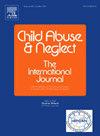Factor structure, measurement invariance and correlates of a modified version of the Short Child Maltreatment Questionnaire (SCMQ) among adolescents in England
IF 3.4
2区 心理学
Q1 FAMILY STUDIES
引用次数: 0
Abstract
Background
Population surveys on child wellbeing require a brief, validated tool to measure child and adolescent maltreatment. The 7-item Short Child Maltreatment Questionnaire (SCMQ), developed by a WHO expert committee, has not been psychometrically tested.
Objective
This study aimed to determine the factor structure, measurement invariance and correlates of a modified version of the SCMQ (6 of its 7 items) in a sample of adolescents attending schools in England.
Methods
Data from 15,155 adolescents (aged 11–18 years) in the OxWell School Survey were used to test a modified 6-item version of the SCMQ. Information on depression, anxiety, self-harm, smoking, alcohol use, substance use, bullying victimization, peer victimization/dating abuse was collected using a structured, self-report questionnaire. The factor structure, reliability, and construct validity of the SCMQ was examined, and measurement invariance was tested across gender, age, and ethnicity.
Results
Findings from exploratory factor analyses revealed a stable one-factor model, while two- and three-factor models showed instability, suggesting that a unidimensional solution best represented the data. CFA confirmed a one-factor model [χ2(df) = 92.265(12); CFI 0.992 TLI 0.987 RMSEA 0.02 90 % CI [0.020, 0.029]). Around 16.3 % of the sample experienced any form of maltreatment, with exposure rates for specific types of maltreatment ranging from 0.6 to 11.6 %. Full configural, metric, scalar invariance was observed across all groups. Internal consistency (McDonald's omega) was adequate (0.71). The SCMQ demonstrated good construct validity, showing significant associations with health behaviours (substance use, alcohol use, smoking), mental health challenges (self-harm, depression, anxiety) and interpersonal violence (dating abuse, bullying) with effect sizes ranging from small to moderate.
Conclusions
The SCMQ scores demonstrated acceptable reliability and validity among adolescents in England. It can be used to screen for maltreatment in large surveys and across diverse child populations. Opportunities to validate the SCMQ in other contexts would be beneficial.
英国青少年短儿童虐待问卷(SCMQ)修正版的因素结构、测量不变性及相关因素
关于儿童福利的人口调查需要一种简短、有效的工具来衡量儿童和青少年的虐待情况。由世卫组织专家委员会编制的7项儿童虐待简短问卷(SCMQ)尚未经过心理测量学测试。目的本研究旨在确定一个修改版本的SCMQ(其7个项目中的6个)在英国上学的青少年样本中的因素结构、测量不变性和相关因素。方法采用来自OxWell学校调查的15,155名青少年(11-18岁)的数据来测试修改后的6项SCMQ。通过结构化的自我报告问卷收集了有关抑郁、焦虑、自残、吸烟、饮酒、物质使用、欺凌受害、同伴受害/约会虐待的信息。研究了SCMQ的因素结构、信度和结构效度,并测试了不同性别、年龄和种族的测量不变性。结果探索性因子分析的结果显示,单因素模型稳定,而两因素和三因素模型不稳定,表明一维解最能代表数据。CFA证实了单因素模型[χ2(df) = 92.265(12);[0.020, 0.029] (Cfi = 0.992 ~ 0.987)。大约16.3%的样本经历过任何形式的虐待,具体类型的虐待暴露率从0.6%到11.6%不等。在所有组中均观察到完全的构型、度量和标量不变性。内部稠度(麦当劳的omega)是足够的(0.71)。SCMQ表现出良好的结构效度,与健康行为(物质使用、酒精使用、吸烟)、心理健康挑战(自残、抑郁、焦虑)和人际暴力(约会虐待、欺凌)有显著的关联,效应量从小到中等。结论SCMQ评分在英国青少年中具有可接受的信度和效度。它可用于在大型调查和不同儿童群体中筛查虐待行为。在其他上下文中验证SCMQ的机会将是有益的。
本文章由计算机程序翻译,如有差异,请以英文原文为准。
求助全文
约1分钟内获得全文
求助全文
来源期刊

Child Abuse & Neglect
Multiple-
CiteScore
7.40
自引率
10.40%
发文量
397
期刊介绍:
Official Publication of the International Society for Prevention of Child Abuse and Neglect. Child Abuse & Neglect The International Journal, provides an international, multidisciplinary forum on all aspects of child abuse and neglect, with special emphasis on prevention and treatment; the scope extends further to all those aspects of life which either favor or hinder child development. While contributions will primarily be from the fields of psychology, psychiatry, social work, medicine, nursing, law enforcement, legislature, education, and anthropology, the Journal encourages the concerned lay individual and child-oriented advocate organizations to contribute.
 求助内容:
求助内容: 应助结果提醒方式:
应助结果提醒方式:


